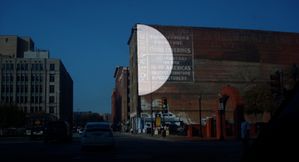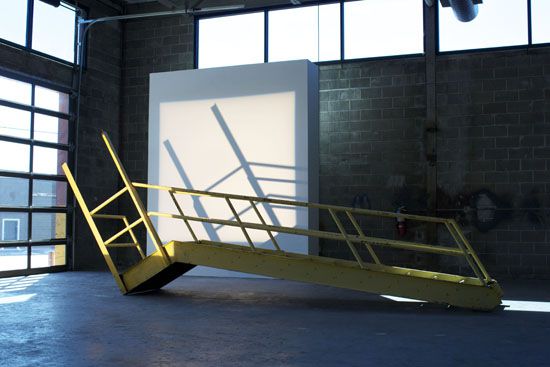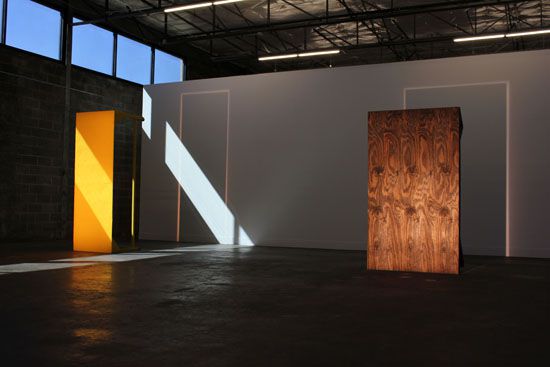
Exposition collective
(Bernard Guelton, Isabelle Lartault, Lorenzo Menoud, Michel Verjux)
Plaine de Plainpalais, Genève
11 mai - 21 mai

Exposition collective
(Bernard Guelton, Isabelle Lartault, Lorenzo Menoud, Michel Verjux)
Plaine de Plainpalais, Genève
11 mai - 21 mai


Exposition personnelle
Galerie Mark Müller, Zurich
6 mai - 4 juin 2011
Exposition collective
A arte Studio Invernizzi, Milan
9 avril - 3 mai 2011
MiArt Milano 8-11 avril
Art Brussels 28 avril - 1er mai
Exposition collective
Artcurial, Paris
1er - 3 avril 2011

Breathe, Walk, Look
Exposition personnelle
Dallas Contemporary Art Center
12 février - 27 mars 2011



Brève présentation de l'oeuvre
« Le minimum nécessaire et suffisant : de la lumière en acte dans une situation donnée (dans un espace et un temps donnés) donnant à voir aux yeux du spectateur cette situation d’exposition elle-même[1]. »
« Non pas la lumière, mais l’éclairage[2]. »
« Éclairer, et seulement éclairer, c’est déjà exposer[3]. »
Mes œuvres — des « éclairages » principalement constitués de projections de lumière, orientées, cadrées et focalisées —, peuvent être vues et, selon moi, doivent même être vues, non seulement comme de simples images, formes ou signes géométriques de lumière projetée dans l’espace réel, mais aussi et surtout à la fois comme des indices et des symboles de l’évènement, de l’acte, du fait, de l’objet et du dispositif que représente, selon les angles sous lesquels nous l’abordons, l’exposition de quoi que ce soit au regard du regardeur.
Ces œuvres renvoient à une pratique artistique concentrée sur l’acte de montrer, resserrée sur ce qui relève de l’exposition, en général et en particulier, et réduite, avec un brin d’ironie, à la création d’« éclairages ». Ce qui est en jeu, ce qui est assumé et revendiqué ici, c’est tout d’abord la dimension existentielle de l’activité artistique ; c’est ensuite un refus (autant que faire se peut) de l’œuvre comme objet matériel (ou simple marchandise) ; et c’est, enfin, une volonté d’atteindre un degré relatif de précision et de clarification conceptuelles dans le champ de l’art (aussi vaste, incertain et complexe soit-il).
À travers une telle pratique artistique, je cherche à exemplifier la singularité de l’œuvre tout en questionnant sa place et son statut, aujourd’hui. Mon but est d’utiliser aussi bien sa capacité à nous émouvoir que celle à nous faire interagirphysiquement avec les différents éléments, facteurs ou paramètres qui lui sont propres et ceux qui sont propres à l’endroit où nous nous trouvons et au moment où elle nous est exposée et, bien entendu, d’utiliser en même temps sa capacité à interroger notre regard sur le monde environnant.
(Atelier du Père-Lachaise, Paris, à l’occasion de mes 19867 jours de vie, automne 2010).
« Les rayons qui ruissellent à travers le volet ne seront pas longs à être oubliés quand le volet sera grand ouvert[4]. »
Henry David Thoreau
Si nous voulions exposer au regard de quelqu’un une œuvre d’art visuelle et plastique qui soit à la fois claire, simple et positive, nous devrions peut-être tout faire pour que cette œuvre amène le visiteur (de l’exposition dans laquelle elle lui est montrée) dans un état où le seul fait de respirer, de marcher et de regarder semble lui suffire.
En se confrontant, aujourd’hui, aux problématiques de l’habitat, de l’espace et de la lumière, l’œuvre d’art peut réaliser un tel projet. Elle peut intégrer dans ses matériaux mêmes des traits picturaux et sculpturaux relevant de l’architecture, de la cité et de l’éclairage.
Une telle approche de l’œuvre d’art est tout autant sensible, réaliste que rationnelle. Et c’est selon cette approche que je crée mes œuvres, en général, et que j’ai conçu, en particulier, mon exposition à l’intérieur et à l’extérieur du Dallas Contemporary Art Center.
(Chalon-sur-Saône, à l’occasion de mes 19933 jours de vie, hiver 2010).
---
I
Short presentation of the work
“The necessary and sufficient minimum: light enacted in a given situation (in a given space and time), offering the exposition situation itself to the spectator’s eyes[5]..”
“Not light but the act of lighting[6].”
“To put light on something, and only that, is already to expose[7].”
My works — “éclairages” mainly composed of light projections which are directed, framed and focused — can and, in my opinion, must even be seen not only as simple images, forms or geometric signs of light projected in real space, but also and above all as both indexes and symbols of the event, the act, the fact, the object and the process which the exposition of anything at all, depending on the angle from which it is viewed, represents in the eyes of the viewer.
These works refer to an artistic practice which concentrates on the act of showing, focusing, in general and in particular, on what exposition actually is, a practice which is reduced, with a touch of irony, to the creation of “éclairages”. What is involved, assumed and asserted here is first and foremost the existential dimension of artistic activity, then the refusal (as far as it is possible) of artwork as a material thing (or a simple commodity), and finally the will to achieve a relative degree of conceptual precision and clarification in the field of art (however broad, uncertain and complex it may be).
Through this artistic practice, I seek to exemplify the singularity of the work while raising questions about its place and status today. My aim is to use its capacity both to move us and to provoke physical interactions with different elements, factors and parameters that are specific to the work as well as to the place we are in and the moment at which it is exposed, and of course, at the same time, to use its capacity to question the way we look upon the world at large.”
(Michel VERJUX, Père-Lachaise studio, Paris, for my 19867 days of life, Autumn 2010).
Breathe, Walk, Look
" The rays which stream through the shutter will be no longer remembered when the shutter is wholly removed."
Henry David Thoreau
If our aim was to expose to somebody’s eyes a work of visual and plastic art which would be at once clear, simple and positive, we should perhaps focus on the work’s ability to produce in the visitor (to the exhibition in which the work is being shown) a state in which simply to breathe, walk and look would seem to be enough.
When a work of art today confronts such questions as habitat, space and light, this aim can be achieved and the materials themselves can include pictural and sculptural features relating to architecture, city and lighting.
Apprehending a work of art in such a way has as much to do with sensitivity and realism as with rationality. And this is the way that I create my works, in general, and the way I have conceived my exhibition, in particular, indoors and outdoors of the Dallas Contemporary Art Center.
(Chalon-sur-Saône, for my 19933 days of life, Winter 2010) [9].
[1] Michel Verjux, Notes numérotées à mon nombre de jours de vie, note n°10054 (1983), inédit.
[2] Michel Verjux, Notes numérotées…., op. cit., note n° 9987 (1983).
[3] Michel Verjux, ibid., note n° 10818 (1986).
[4] Henry David Thoreau, Walden ou la vie dans les bois[1854], chapitre IV, « Bruits », trad. franç. Jeanne Chantal et Thierry Fournier, Lausanne, L’Âge d’Homme, 1985, p. 97.
[5] Michel Verjux, Notes numérotées à mon nombre de jours de vie, note n°10054 (1983), unpublished.
[6] Michel Verjux, Notes numérotées…., op. cit., note n° 9987 (1983).
[7] Michel Verjux, ibid., note n° 10818 (1986).
[8] Henry David Thoreau, Walden ; or, Life in the Woods, ch. IV « Sounds », ed. Jeffrey Cramer, New Haven : Yale University Press, 2004. Originally published in 1854.
[9] English translation by Margaret Scollen-Tomarchio.
Galerie Mark Müller
Zürich
15 janvier - 12 mars 2011